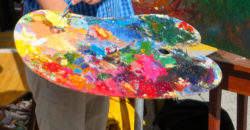 Every time I teach a class, I learn more from the students than I could ever possibly teach them. From some, I learn how to be a better learner, from others I get insight into what happens when learning stops and the need to perform or win starts, from some I learn what true lifelong engagement is, and from some, I learn what going through the motions looks like, what pain is, what searching looks like.
Every time I teach a class, I learn more from the students than I could ever possibly teach them. From some, I learn how to be a better learner, from others I get insight into what happens when learning stops and the need to perform or win starts, from some I learn what true lifelong engagement is, and from some, I learn what going through the motions looks like, what pain is, what searching looks like.
This past July in Oregon was no exception to that rule. Extraordinary communities of learners were created, sparked, engaged, and dispersed, some to remain connected and others not. As with any extraordinary experience, it’s hard to maintain out of context, away from the carbon-pressing intensity of the Institute and in the great sucking noise we call time. We all spread out at the end like specks of magnetic shavings in a tiny drinking glass-sized pond suddenly scattering to our different corners of the world as if pulled by large magnets. Sometimes, small moments are all that remain.
One such moment came in the first week of the Institute this year, while teaching a course on humor and play as intercultural tools. Our conversation had turned to humor that makes fun of a group—like the Polish jokes that my husband endures, or blond jokes or racist jokes or gay jokes. How do we navigate that kind of humor, what are our responsibilities to speak up, what purpose do such jokes serve, what difficulties do we face in speaking up against them—and what costs there are in not speaking out against them, we all asked and contemplated. Racist humor inspires hate, we know. What’s our best defense?
People offered examples of how destructive such humor is, how we are—in effect—participating by not speaking up against it. I offered Allport’s work on the stages of prejudice in which he found that prejudice reveals itself in many different ways, starting with avoidance, then moving to jokes and slur, then discrimination, violence, and genocide, each building on the one before. So while we think that jokes and slurs are sometimes not serious, they are, each sliding into the next, often without our realizing it. That’s not to say we should become humorless, but that we need to acknowledge the power of our words and laughter as tools for either inclusion or exclusion. The conversation continued until Esther Louie spoke up to offer a tool that she uses.
“I learned this from a friend,” she quietly said, “and it’s been helpful to me when someone makes an ethnic slur or joke at the expense of some group.” Like others of us in the room, she expressed feeling uncomfortable and wanting to do something, but sometimes not knowing what to say in such instances. “When that happens,” she continued, “I simply say, ‘I don’t see the truth in that.’ It helps me own my own reaction, honors my desire and responsibility to respond in a way that registers my reaction, and helps me speak my truth.”
We were struck silent by the beauty of the phrase: “I don’t see the truth in that.”
Through the rest of the week–and now beyond–it was a phrase that we kept coming back to. And so, E is for Esther’s solution, a phrase that helps us respond, not react, that helps us register our willingness to think for ourselves, not agree with blanket stereotypes, and that honors our responsibility to counter racist and other statements in a way that helps us speak our own truth.
Try it on for size, make it your own.
“I don’t see the truth in that.”
"Really? I don’t see the truth in that."
"I just don’t see the truth in that."
E is for Esther and all those from whom we learn.
 Every time I teach a class, I learn more from the students than I could ever possibly teach them. From some, I learn how to be a better learner, from others I get insight into what happens when learning stops and the need to perform or win starts, from some I learn what true lifelong engagement is, and from some, I learn what going through the motions looks like, what pain is, what searching looks like.
Every time I teach a class, I learn more from the students than I could ever possibly teach them. From some, I learn how to be a better learner, from others I get insight into what happens when learning stops and the need to perform or win starts, from some I learn what true lifelong engagement is, and from some, I learn what going through the motions looks like, what pain is, what searching looks like.






